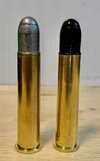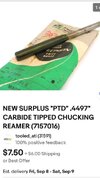JimGnitecki
Member
- Joined
- Mar 28, 2010
- Messages
- 1,258
Ok, ONE mystery is solved, but a different one created:
The bore and chamber are completely clear. There is no obstruction anywhere.
BUT, I had assumed that the rifle was somehow creating that interference ring on the bullet after it appeared, by interfering with the entry of the bullet into the throat somehow. Not so.
I have now traced the source of the interference ring to be the Hornady micrometer seating die I am using!
I placed a brand new uncoated bullet and empty sized and expanded case into the press and operated the handle. At one point as the bullet was rising up into the die, there was an audible and feelable "click". When I retracted the only partially seated bullet / case assembly from the die, there was the "interference ring" which I had wrongly attributed to metal in the rifle hitting the ogive.
I have never experienced anything like this before with a die.
I now need to disassemble the die enough to figure out what is happening.
I don't think though that this will change the fact that a cartridge loaded with this bullet will not chamber in the rifle, if loaded to the COAL recommended by Lyman. After all, the ring did NOT "add" diameter to the bullet ogive. It simply damaged its surface. To load the bullet, I had already determined by actual trial that I would need to reduce the COAL by at least .036". Given the low 14,000 psi to 17,000 psi pressure rnage the load table shows for this bullet at the Trapdoor loads I am wanting to use, is a .036" reduction in COAL likely to make the loads unsafe?
Your thoughts on both:
1. The potential reduction in COAL?
and
2. What has happened inside the Hornady micrometer seating die?
Jim G
The bore and chamber are completely clear. There is no obstruction anywhere.
BUT, I had assumed that the rifle was somehow creating that interference ring on the bullet after it appeared, by interfering with the entry of the bullet into the throat somehow. Not so.
I have now traced the source of the interference ring to be the Hornady micrometer seating die I am using!
I placed a brand new uncoated bullet and empty sized and expanded case into the press and operated the handle. At one point as the bullet was rising up into the die, there was an audible and feelable "click". When I retracted the only partially seated bullet / case assembly from the die, there was the "interference ring" which I had wrongly attributed to metal in the rifle hitting the ogive.
I have never experienced anything like this before with a die.
I now need to disassemble the die enough to figure out what is happening.
I don't think though that this will change the fact that a cartridge loaded with this bullet will not chamber in the rifle, if loaded to the COAL recommended by Lyman. After all, the ring did NOT "add" diameter to the bullet ogive. It simply damaged its surface. To load the bullet, I had already determined by actual trial that I would need to reduce the COAL by at least .036". Given the low 14,000 psi to 17,000 psi pressure rnage the load table shows for this bullet at the Trapdoor loads I am wanting to use, is a .036" reduction in COAL likely to make the loads unsafe?
Your thoughts on both:
1. The potential reduction in COAL?
and
2. What has happened inside the Hornady micrometer seating die?
Jim G



